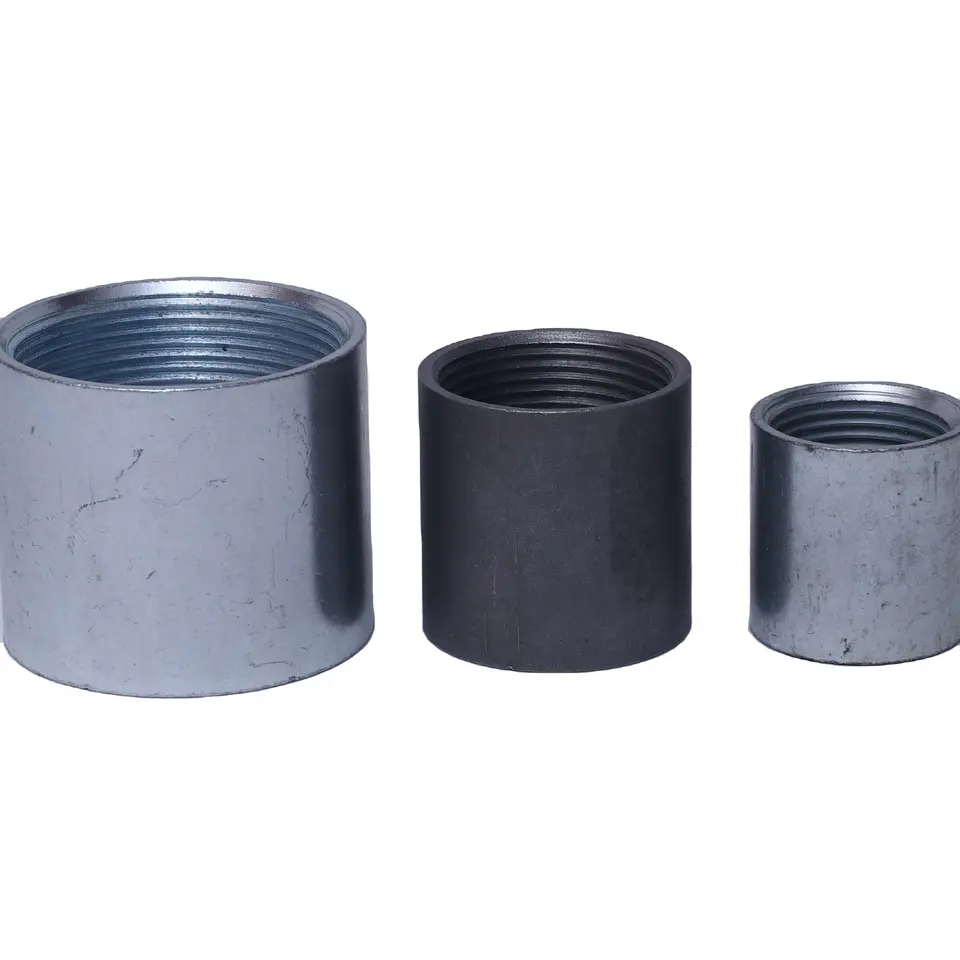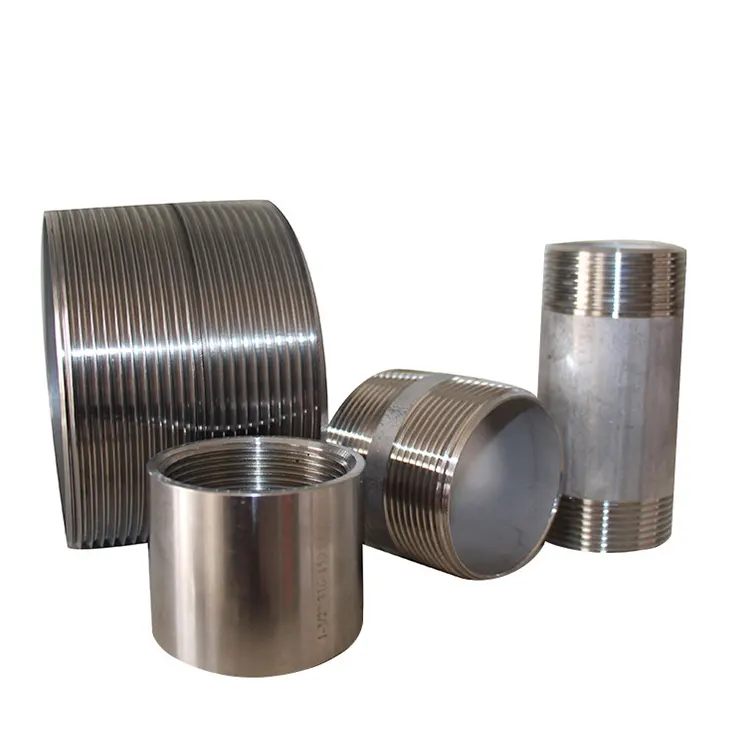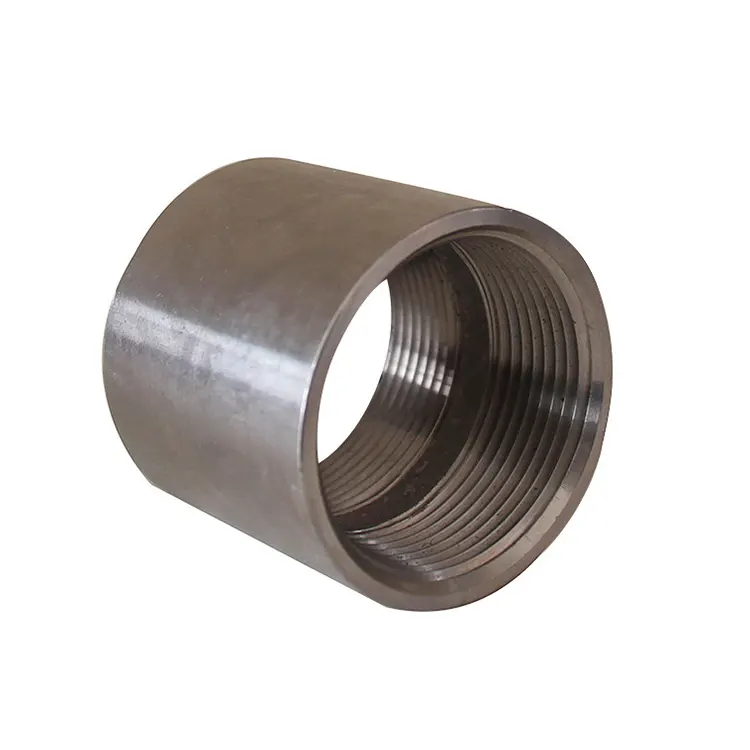Product Description
Dimension
1/2″ to 4″(DN15~DN100)
Range(Wall Thickness):
3000LB to 9000LB
XS, Sch80, Sch160, XXS.
Standard
ASME/ANSI B16.11
MSS SP-79, MSS SP-83, MSS SP-114
JIS B2316, JIS B2302 etc.
Material:
General Stainless steel, Super Stainless Steel, Duplex Stainless Steel (Ferritic-Austenitic Stainless Steel), Austenitic Stainless Steel, Martensitic Stainless Steel, Ferritic Stainless Steel. etc.
Material Grade(Only lists part):
| TYPE | ASTM | EN/DIN | JIS |
| General Stainless Steel | A182: F304, F304L, F304H, F304N, F304LN F310, F310H, F310MoLN F316, F316L, F316H, F316N, F316LN, F316Ti F317, F317L F321, F321H F347, F347H, F347LN F304/F304L, F316/F316L, F317/F317L, F321/F321H. F6a, F6b, F429, F430 S31727, S32053 F20, F44, F45, F46 F47, F48, F49, F56 F58, F62, F63, F64, F70 |
1.4301(X5CrNi1810) 1.4306(X2CrNi1911) 1.4301H(X5CrNBi1810H) 1.4311(X2CrNiN1810) 1.4845(X12CrNi2521) 1.4401(X5CrNiMo17122) 1.4404(X2CrNiMo171321) 1.4919(X6CrNiMo1713) 1.4406(X2CrNiMoN17122) 1.4571(X6CrNiMoTi17122) 1.4438(X2CrNIMo18164) 1.4449(X5CrNiMo1713) 1.4541(X6CrNiTi1810) 1.4541H(X6CrNiTi1810H) 1.4550(X6CrNiNb1810) |
SUS304 SUS304H SUS304L SUS310 SUS310S SUS316 SUS316H SUS316L SUS316Ti SUS317 SUS317L SUS321 SUS321H SUS347 SUS347H |
| Duplex Steel | A182: F51(UNS S31803) F53(UNS S32750) F55(UNS S32760) F60(UNS S32205) F50, F52, F54, F57 F59, F61, F65, F66 F67, F68, F69, F71 |
1.4462(X2CrNiMoN22-5-3), 1.4410(X2CrNiMoN25-7-4) 1.4501(X2CrNiMoCuWN25-7-4) |
SUS329J3L SUS329J3LTB SUS329J3LTP |
| Super Stainless Steel | A182: F904L(UNS N5714) F44(UNS S31254 or 254SMO) |
1.4539(X2NiCrMoCu25-20-5), 1.4547(X2NiCrMoCu20-18-7) |
SUS890L |
/* March 10, 2571 17:59:20 */!function(){function s(e,r){var a,o={};try{e&&e.split(“,”).forEach(function(e,t){e&&(a=e.match(/(.*?):(.*)$/))&&1
What are the Signs of Wear, Corrosion, or Damage in a Half Coupling?
A half coupling, like any other pipe fitting, can experience wear, corrosion, or damage over time due to various factors. Regular inspection is crucial to detect any issues early on and prevent potential leaks or failures in piping and plumbing systems. Here are some signs to look for to identify wear, corrosion, or damage in a half coupling:
- Visible Corrosion: Check for any signs of rust or corrosion on the surface of the half coupling. Corrosion can weaken the material and lead to leaks or structural failure. Surface discoloration, rough patches, or flaking of the metal are all indicators of possible corrosion.
- Thread Damage: For threaded half couplings, inspect the threads carefully. Look for signs of stripping, galling, or deformation. Damaged threads can compromise the integrity of the connection and may result in leaks.
- Cracks or Fractures: Examine the half coupling for any cracks, fractures, or signs of deformation. Cracks can lead to leaks and should be addressed immediately to prevent further damage.
- Worn Socket or Weld Seam: In the case of socket weld or butt weld half couplings, inspect the socket or weld seam for signs of wear or damage. A worn socket may not provide a secure fit for the smaller pipe, while defects in the weld can compromise the joint’s strength and integrity.
- Leaks: Any visible leaks or indications of moisture around the joint or coupling are clear signs of a problem. Leaks can be caused by damaged threads, corroded surfaces, or improper installation.
- Reduced Performance: If the system’s performance declines, such as a decrease in flow rate or pressure, it could be a sign of a partially obstructed or damaged coupling.
- Age and Service Life: Consider the age and service life of the half coupling. Over time, even well-maintained couplings may show signs of wear and fatigue, warranting closer inspection.
If any of these signs are observed, it is essential to take prompt action to address the issues. Depending on the severity of the wear, corrosion, or damage, the appropriate steps may include repairing or replacing the half coupling. In some cases, it may be necessary to inspect adjacent pipes and components for possible effects of the compromised coupling.
Regular maintenance and inspection practices can help identify signs of wear, corrosion, or damage in a half coupling before they escalate into more significant problems. Following manufacturer’s guidelines, adhering to industry standards, and using suitable materials for the application can contribute to the longevity and reliability of the half coupling and the entire piping or plumbing system.
Can a Half Coupling be Used in both Residential and Industrial Applications?
Yes, a half coupling can be used in both residential and industrial applications, depending on the specific requirements of the plumbing or piping system. Half couplings are versatile fittings that find application in various settings due to their design and functionality.
Residential Applications: In residential plumbing systems, half couplings can be utilized for several purposes. They are commonly used in household plumbing repairs and installations where a secure connection between pipes or components is needed. For example, half couplings can be used to attach fixtures such as faucets, showerheads, or water heaters to the water supply lines. Additionally, they are employed in various DIY projects and renovations around the house, providing a reliable and leak-resistant connection between pipes of different sizes or materials.
Industrial Applications: Half couplings are extensively used in industrial applications due to their ability to connect pipes and components in a range of systems. In industrial settings, half couplings are employed in piping systems for water, air, chemicals, gases, and other fluids. They are commonly found in power plants, chemical processing plants, refineries, petrochemical facilities, and manufacturing plants, among others. These couplings play a crucial role in creating reliable joints for conveying materials and maintaining the overall integrity of the industrial processes.
While half couplings are suitable for both residential and industrial applications, there are certain considerations to keep in mind. For residential use, the materials and pressure ratings of the half couplings should be appropriate for household water supply systems, which generally operate at lower pressures compared to industrial systems. In industrial applications, the materials, dimensions, and pressure ratings of the half couplings must meet the specific requirements of the industrial processes, which often involve higher pressures and harsher environmental conditions.
Regardless of the application, it is essential to select high-quality half couplings that comply with relevant industry standards and are appropriate for the intended use. Proper installation and maintenance of the couplings are also crucial to ensure a leak-free and reliable connection in both residential and industrial settings.
What are the Various Types of Half Couplings and Their Specific Applications?
Half couplings come in different types, each designed to cater to specific applications and requirements in piping and plumbing systems. The various types of half couplings and their specific applications are as follows:
- Threaded Half Couplings: Threaded half couplings have internal threads on one end, allowing for easy connection to pipes with matching external threads. These couplings are commonly used in applications where a secure and leak-proof joint is needed, such as connecting valves, instruments, or equipment to the pipeline.
- Socket Weld Half Couplings: Socket weld half couplings have a socket on one end, which allows for the insertion of the pipe without threading. The joint is then welded for a strong and permanent connection. Socket weld half couplings are widely used in high-pressure applications and systems that require frequent disassembly.
- Butt Weld Half Couplings: Butt weld half couplings are designed for butt welding, which involves welding the coupling directly to the larger pipe end. The other end can be used to attach a smaller pipe. These couplings are commonly used in critical applications where a smooth and continuous inner surface is required to prevent turbulence and pressure losses.
- Reducing Half Couplings: Reducing half couplings are used when a transition between different pipe sizes is needed. One end of the coupling has larger threads or a larger socket to accommodate a larger pipe, while the other end has smaller threads or a smaller socket to connect a smaller pipe. These couplings are commonly used in systems that require a change in pipe size, such as reducing the flow rate or connecting equipment with different pipe sizes.
- Mechanical Grip Half Couplings: Mechanical grip half couplings use a mechanical mechanism to grip and secure the smaller pipe without welding or threading. They are commonly used in temporary connections or situations where frequent disassembly is necessary, such as in temporary test setups or during equipment maintenance.
The choice of half coupling type depends on the specific application, the pipe materials, the operating conditions, and the required joint strength. It is essential to follow industry standards and guidelines when selecting the appropriate type of half coupling to ensure the safety and efficiency of the piping or plumbing system.
In summary, various types of half couplings cater to different needs in piping and plumbing systems. Whether for permanent connections, temporary applications, or transitions between different pipe sizes, half couplings offer versatile solutions for joining pipes securely and efficiently.
editor by CX 2024-02-19




